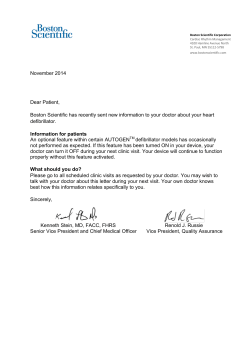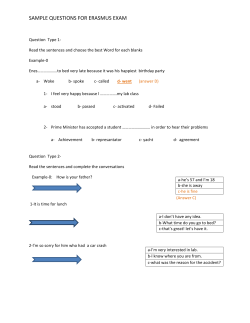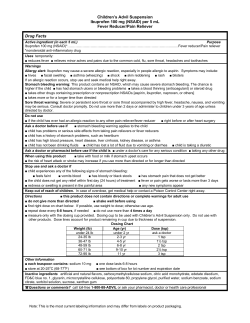
Real-World Data Published in Clinical Cardiology Show Consistent
News Release Media Contacts: Kristina Chang Tel: (908) 927-2416 Mobile: (201) 213-4115 kchang12@its.jnj.com Christina Chan Tel: (908) 927-5769 Mobile: (908) 635-2406 cchan20@its.jnj.com Investor Relations Contacts: Johnson & Johnson Louise Mehrotra Tel: (732) 524-6491 Johnson & Johnson Lesley Fishman Tel: (732) 524-3922 Real-World Data Published in Clinical Cardiology Show Consistent Safety Performance of Once-Daily XARELTO® Findings Add to Rigorous Post-Marketing Safety Program for XARELTO® in Routine Clinical Practice Raritan, NJ (January 14, 2015) — A new post-marketing study evaluating the safety of once-daily XARELTO® (rivaroxaban) shows, in patients with non-valvular atrial fibrillation (NVAF), rates and patterns of major bleeding in routine clinical practice are generally consistent with those observed in Phase 3 clinical trials used to approve the medicine for this indication. These fifteen-month results, published today in Clinical Cardiology, represent initial findings from an ongoing, five-year, observational study of patients using XARELTO® daily over the course of their lives. 1 “These findings reaffirm the safety profile of XARELTO,” said W. Frank Peacock (co-author of the manuscript), M.D., FACEP, Associate Chair and Research Director, Emergency Medicine, Baylor College of Medicine. “We anticipate future findings from this five-year observational study will continue to provide real-world information about the use of XARELTO in routine clinical practice.” Researchers analyzed data from January 1, 2013 to March 31, 2014 using U.S. Department of Defense (DoD) integrated electronic healthcare records, via a collaboration with Health ResearchTx LLC (HRTX), to evaluate major bleeding rates in NVAF patients treated with XARELTO® in the real-world clinical setting. Of the 27,467 patients receiving XARELTO®, an incidence of major bleeding was observed at 2.86 per 100 person-years, which was generally consistent with rates reported in the ROCKET-AF clinical trial.1 Additionally, patients who experienced major bleeding were older (with a mean age of 78) and fatal outcomes were rare. Janssen Pharmaceuticals, Inc. (Janssen) designed the study, in conjunction with DoD and HRTX, and in agreement with the U.S. Food and Drug Administration (FDA), to proactively ascertain, analyze and report potential side effects with XARELTO® use, including major bleeding events, associated risk factors and bleeding-related clinical outcomes in NVAF patients receiving XARELTO®. Major bleeding cases for this study were ascertained using a validated Cunningham (2011) algorithm, which was generally consistent with, but not identical to the definition of major bleeding used in clinical studies, because it relied on retrospectively identified electronic medical records. While the results are not intended for any direct comparison, these data show rates and patterns of major bleeding were generally consistent with those reported in the previous large randomized FDA registration trial of XARELTO®. “After more than three years on the market and more than 10 million patients prescribed we continue to monitor the safety performance of our medicine. We are pleased with these findings, which demonstrate XARELTO is performing as expected in the real-world setting,” said Paul Burton, M.D., Ph.D., Vice President, Medical Affairs, Janssen. “With studies completed in over 85,000 patients and ongoing post-marketing studies that will include more than 74,000 patients, we continue to advance our real world data to ensure doctors and patients are equipped with the latest information about XARELTO to optimize patient care.” 1 Goodman SG, et al. Factors Associated with Major Bleeding Events: Insights from the Rivaroxaban Once-daily oral Direct Factor Xa Inhibition Compared with Vitamin K Antagonism for Prevention of Stroke and Embolism Trial in Atrial Fibrillation 23(ROCKET AF), Journal of the American College of Cardiology (2013), doi:0.1016/j.jacc.2013.11.013. In press. 2 By the time of its completion, more than 275,000 patients will have participated in the XARELTO® clinical development program, other completed and ongoing clinical trials, investigative registries and non-interventional studies. As a part of this program, Janssen is conducting a number of post-marketing surveillance studies, through its ongoing development partnership with Bayer HealthCare, to further assess the benefit-risk profile of XARELTO® in real-world settings. Results to date have shown the safety and efficacy observed since the medicine was approved are generally consistent with completed Phase 3 clinical trials. It is anticipated that by July 2015, this robust program of Phase 4, observational studies will include more than 74,000 patients across six approved indications, including the following studies: XAMOS is a non-interventional Phase 4 study, which showed in routine clinical practice, patients treated with XARELTO® were observed to have a numerically lower rate of venous thromboembolism (VTE) in patients after major orthopedic surgery, and were not observed to have a higher rate of major bleeding, compared to standard of care. The study was not randomized, so the comparison needs to be interpreted with caution. The study included over 17,700 patients from 37 countries. XALIA is a multi-center, prospective, non-interventional, observational study currently investigating the safety and efficacy of a single-drug approach with XARELTO® compared with standard therapy for the treatment of acute VTE. The study cohort will include more than 4,800 patients in over 20 European countries. The first patient was enrolled in June 2012, with results expected in 2015. XANTUS is a prospective, international, observational, post-authorization, noninterventional study designed to collect safety and efficacy data on the use of XARELTO® for stroke prevention in routine clinical practice. This ongoing study will enroll approximately 6,000 patients with NVAF prescribed XARELTO®, irrespective of their level of stroke risk. While this study is focused in Europe, similar studies (XANTUS-EL and XANAP) are ongoing in Latin America and Asia-Pacific. Additionally, data published in Current Medical Research and Opinion found XARELTO® and warfarin did not differ significantly in real-world effectiveness and safety for the prevention of stroke and systemic embolism in patients with NVAF. Findings from this U.S. healthcare claims database evaluating more than 18,270 patients also showed XARELTO® was associated with fewer cases of VTE and significantly better treatment persistence compared to warfarin. 3 In addition, the following non-interventional registries will provide further insights into anticoagulant treatment patterns in the real-world setting: GARFIELD AF is an observational, multi-center registry of men and women with newly diagnosed atrial fibrillation (AFib) and with at least one investigator-determined risk factor for stroke in real-life practice. The GARFIELD AF Registry is an academic research initiative, led by the Thrombosis Research Institute (TRI) and a multidisciplinary Steering Committee, supported by an unrestricted educational grant from Bayer Pharma AG (Bayer). The registry aims to enroll more than 51,500 newly diagnosed AFib patients and 5,000 patients diagnosed retrospectively at risk of stroke at more than 1,000 sites in 34 countries. To date, more than 36,000 patients have been recruited. GARFIELD VTE is an observational, multi-center registry, evaluating the acute and long-term management and outcomes of VTE in 10,000 patients at about 500 centers in 25 countries. This academic research initiative, led by TRI with support from Bayer, aims to provide a real-world perspective on the treatment of VTE. ORBIT-AF is a multicenter, prospective outpatient disease registry to identify realworld treatment patterns of AFib in the U.S. The registry will evaluate the patient population with regards to demographics, clinical factors, risk stratification and geographic regions, with a particular focus on the utilization, effectiveness and safety of antithrombotic therapies for the prevention of stroke. The study will enroll approximately 10,000 patients. About XARELTO® (rivaroxaban) XARELTO® works by blocking the blood clotting Factor Xa. XARELTO® does not require routine blood monitoring. XARELTO® has a broad indication profile and is approved for six indications that include: 1. To reduce the risk of strokes and blood clots in patients with atrial fibrillation not caused by a heart valve problem. For patients currently well managed on warfarin, there is limited information on how XARELTO® and warfarin compare in reducing the risk of stroke. 2. To treat patients with deep vein thrombosis (DVT). 3. To treat patients with pulmonary embolism (PE). 4. To reduce the risk of recurrence of DVT or PE following an initial six-month treatment for acute venous thromboembolism. 4 5. To reduce the risk of blood clots in the legs and lungs of patients who have just had knee replacement surgery. 6. To reduce the risk of blood clots in the legs and lungs of patients who have just had hip replacement surgery. Janssen and Bayer HealthCare together are developing rivaroxaban. For more information about XARELTO®, visit www.xarelto-us.com. The XARELTO® CarePath™ Support Program is a resource designed for healthcare providers, patients and caregivers. Visit www.xareltocarepath.com or call 1-888-XARELTO to learn more about the XARELTO® CarePath™ resources focused on access, education and adherence. IMPORTANT SAFETY INFORMATION: WHAT IS THE MOST IMPORTANT INFORMATION I SHOULD KNOW ABOUT XARELTO®? • For people taking XARELTO® for atrial fibrillation: People with atrial fibrillation (an irregular heart beat) are at an increased risk of forming a blood clot in the heart, which can travel to the brain, causing a stroke, or to other parts of the body. XARELTO® lowers your chance of having a stroke by helping to prevent clots from forming. If you stop taking XARELTO®, you may have increased risk of forming a clot in your blood. Do not stop taking XARELTO® without talking to the doctor who prescribes it for you. Stopping XARELTO® increases your risk of having a stroke. If you have to stop taking XARELTO®, your doctor may prescribe another blood thinner medicine to prevent a blood clot from forming. • XARELTO® can cause bleeding, which can be serious, and rarely may lead to death. This is because XARELTO® is a blood thinner medicine that reduces blood clotting. While you take XARELTO® you are likely to bruise more easily and it may take longer for bleeding to stop. You may have a higher risk of bleeding if you take XARELTO® and take other medicines that increase your risk of bleeding, including: • • • • • • Aspirin or aspirin-containing products Non-steroidal anti-inflammatory drugs (NSAIDs) Warfarin sodium (Coumadin®, Jantoven®) Any medicine that contains heparin Clopidogrel (Plavix®) Other medicines to prevent or treat blood clots Tell your doctor if you take any of these medicines. Ask your doctor or pharmacist if you are not sure if your medicine is one listed above. 5 Call your doctor or get medical help right away if you develop any of these signs or symptoms of bleeding: • Unexpected bleeding or bleeding that lasts a long time, such as: • Nosebleeds that happen often • Unusual bleeding from gums Menstrual bleeding that is heavier than normal, or vaginal bleeding • Bleeding that is severe or that you cannot control • Red, pink, or brown urine Bright red or black stools (looks like tar) • Cough up blood or blood clots Vomit blood or your vomit looks like “coffee grounds” • Headaches, feeling dizzy or weak • Pain, swelling, or new drainage at wound sites Spinal or epidural blood clots (hematoma): People who take a blood thinner medicine (anticoagulant) like XARELTO®, and have medicine injected into their spinal and epidural area, or have a spinal puncture, have a risk of forming a blood clot that can cause long-term or permanent loss of the ability to move (paralysis). Your risk of developing a spinal or epidural blood clot is higher if: • A thin tube called an epidural catheter is placed in your back to give you certain medicine • You take NSAIDs or a medicine to prevent blood from clotting • You have a history of difficult or repeated epidural or spinal punctures • You have a history of problems with your spine or have had surgery on your spine If you take XARELTO® and receive spinal anesthesia or have a spinal puncture, your doctor should watch you closely for symptoms of spinal or epidural blood clots. Tell your doctor right away if you have back pain, tingling, numbness, muscle weakness (especially in your legs and feet), or loss of control of the bowels or bladder (incontinence). XARELTO® is not for patients with artificial heart valves. WHO SHOULD NOT TAKE XARELTO®? Do not take XARELTO® if you: Currently have certain types of abnormal bleeding. Talk to your doctor before taking XARELTO® if you currently have unusual bleeding. • Are allergic to rivaroxaban or any of the ingredients of XARELTO®. WHAT SHOULD I TELL MY DOCTOR BEFORE OR WHILE TAKING XARELTO®? Before taking XARELTO®, tell your doctor if you: • • • • Have ever had bleeding problems Have liver or kidney problems Have any other medical condition Are pregnant or plan to become pregnant. It is not known if XARELTO® will harm your unborn baby. Tell your doctor right away if you become pregnant while taking XARELTO®. If you take XARELTO® during pregnancy, tell your doctor right away if you have bleeding or symptoms of blood loss. Are breastfeeding or plan to breastfeed. It is not known if XARELTO® passes into your breast milk. You and your doctor should decide if you will take XARELTO® or breastfeed. 6 Tell all of your doctors and dentists that you are taking XARELTO®. They should talk to the doctor who prescribed XARELTO® for you before you have any surgery, medical or dental procedure. Tell your doctor about all the medicines you take, including prescription and nonprescription medicines, vitamins, and herbal supplements. Some of your other medicines may affect the way XARELTO® works. Certain medicines may increase your risk of bleeding. See “What is the most important information I should know about XARELTO®?” Especially tell your doctor if you take: • • • • • • • • • Ketoconazole (Nizoral®) Itraconazole (Onmel™, Sporanox®) Ritonavir (Norvir®) Lopinavir/ritonavir (Kaletra®) Indinavir (Crixivan®) Carbamazepine (Carbatrol®, Equetro®, Tegretol®, Tegretol®-XR, Teril™, Epitol®) Phenytoin (Dilantin-125®, Dilantin®) Phenobarbital (Solfoton™) Rifampin (Rifater®, Rifamate®, Rimactane®, Rifadin®) St. John’s wort (Hypericum perforatum) Ask your doctor if you are not sure if your medicine is one listed above. Know the medicines you take. Keep a list of them to show your doctor and pharmacist when you get a new medicine. HOW SHOULD I TAKE XARELTO®? Take XARELTO® exactly as prescribed by your doctor. Do not change your dose or stop taking XARELTO® unless your doctor tells you to. Your doctor will tell you how much XARELTO® to take and when to take it. Your doctor may change your dose if needed. If you take XARELTO® for: o Atrial Fibrillation: Take XARELTO® 1 time a day with your evening meal. If you miss a dose of XARELTO®, take it as soon as you remember on the same day. Take your next dose at your regularly scheduled time. o Blood clots in the veins of your legs or lungs: Take XARELTO® once or twice a day as prescribed by your doctor. Take XARELTO® with food at the same time each day. If you miss a dose of XARELTO®: and take XARELTO® 2 times a day: Take XARELTO® as soon as you remember on the same day. You may take 2 doses at the same time to make up for the missed dose. Take your next dose at your regularly scheduled time. and take XARELTO® 1 time a day: Take XARELTO® as soon as you remember on the same day. Take your next dose at your regularly scheduled time. o Hip or knee replacement surgery: Take XARELTO® 1 time a day with or without food. If you miss a dose of XARELTO®, take it as soon as you remember on the same day. Take your next dose at your regularly scheduled time. 7 • • If you have difficulty swallowing the tablet whole, talk to your doctor about other ways to take XARELTO®. Your doctor will decide how long you should take XARELTO®. Do not stop taking XARELTO® without talking to your doctor first. Your doctor may stop XARELTO® for a short time before any surgery, medical or dental procedure. Your doctor will tell you when to start taking XARELTO® again after your surgery or procedure. Do not run out of XARELTO®. Refill your prescription for XARELTO® before you run out. When leaving the hospital following a hip or knee replacement, be sure that you have XARELTO® available to avoid missing any doses. If you take too much XARELTO®, go to the nearest hospital emergency room or call your doctor right away. WHAT ARE THE POSSIBLE SIDE EFFECTS OF XARELTO®? Please see “What is the most important information I should know about XARELTO®?” above. Tell your doctor if you have any side effect that bothers you or that does not go away. Call your doctor for medical advice about side effects. You are also encouraged to report side effects to the FDA: visit http://www.fda.gov/medwatch or call 1-800-FDA1088. You may also report side effects to Janssen Pharmaceuticals, Inc., at 1-800-JANSSEN (1-800-526-7736). Please click here for full Prescribing Information, including Boxed Warnings, and Medication Guide. About Janssen At Janssen, we are dedicated to addressing and solving some of the most important unmet medical needs of our time in oncology, immunology, neuroscience, infectious diseases and vaccines, and cardiovascular and metabolic diseases. Driven by our commitment to patients, we develop innovative products, services and healthcare solutions to help people throughout the world. Janssen Pharmaceuticals, Inc. is one of the Janssen Pharmaceutical Companies of Johnson & Johnson. Please visit JanssenPharmaceuticalsInc.com for more information. 8 (This press release contains "forward-looking statements" as defined in the Private Securities Litigation Reform Act of 1995 regarding product development. The reader is cautioned not to rely on these forward-looking statements. These statements are based on current expectations of future events. If underlying assumptions prove inaccurate or known or unknown risks or uncertainties materialize, actual results could vary materially from the expectations and projections of Janssen Pharmaceuticals, Inc. and/or Johnson & Johnson. Risks and uncertainties include, but are not limited to: challenges inherent in new product development, including obtaining regulatory approvals; competition, including technological advances, new products and patents attained by competitors; challenges to patents; changes in behavior and spending patterns or financial distress of purchasers of health care products and services; changes to governmental laws and regulations and domestic and foreign health care reforms; and trends toward health care cost containment. A further list and description of these risks, uncertainties and other factors can be found in Johnson & Johnson's Annual Report on Form 10-K for the fiscal year ended December 29, 2013, including in Exhibit 99 thereto, and the company's subsequent filings with the Securities and Exchange Commission. Copies of these filings are available online at www.sec.gov, www.jnj.com or on request from Johnson & Johnson. None of the Janssen Pharmaceutical Companies or Johnson & Johnson undertakes to update any forward-looking statement as a result of new information or future events or developments.) 9
© Copyright 2025










